D. staphisagria
| Growing
History:An
illustrated revision of an article written by David
Bassett for "Delphiniums 98", the YearBook of
the Delphinium Society |
A quick look at books about delphiniums shows
that many begin by referring to the recognition by the ancient
Greeks of the dolphin-like appearance of the unopened flower. The
next sentence then introduces Delphinium staphisagria and
mentions the almost magical properties of its poisonous seeds as
herbal medicine or pesticide. To most gardeners, however, this
plant remains just part of Greek mythology, rather than a living
representative of the flora of Greece. D. staphisagria thus
represents a challenge but in 1997 I succeeded in growing it to
flower.
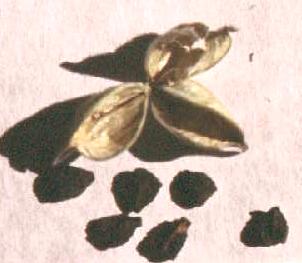 Seed of D. staphisagria, which is a biennial, is
seldom available and my first attempts to grow it some years ago
were with seed Shirley obtained via seed exchanges between
Botanical Gardens and Universities. This time we bought seed
listed by the Archibalds, which had been collected from plants
growing among open scrub at 750m at Anapoli, Crete. The plant
name refers to the resemblance of the leaves to a grape or 'wild
raisin' but you could be forgiven for thinking it was the large
seeds that looked like raisins. They should certainly not be kept
in the cupboard with your dried fruit! The average size for the long
axis of 32 seeds was 6.2 mm and the average width across the
seeds was 5.2 mm. The seeds are angular with flat facets and a
rough, ridged dark brown skin.
Seed of D. staphisagria, which is a biennial, is
seldom available and my first attempts to grow it some years ago
were with seed Shirley obtained via seed exchanges between
Botanical Gardens and Universities. This time we bought seed
listed by the Archibalds, which had been collected from plants
growing among open scrub at 750m at Anapoli, Crete. The plant
name refers to the resemblance of the leaves to a grape or 'wild
raisin' but you could be forgiven for thinking it was the large
seeds that looked like raisins. They should certainly not be kept
in the cupboard with your dried fruit! The average size for the long
axis of 32 seeds was 6.2 mm and the average width across the
seeds was 5.2 mm. The seeds are angular with flat facets and a
rough, ridged dark brown skin.
The first step is to germinate the seeds, so we
tried several methods. I chitted 10 seeds on wet paper towel in a
box on a propagator at 22ºC. Shirley put her 10 seeds on wet
paper towel in a box that went into the fridge for a cold, wet
soak before keeping them at room temperature. In view of the hard
skins, I chipped 5 seeds as is often done for seeds of sweet peas
. After 16 days, there was great joy because one chipped seed had
put out a root. That was in February, but it was to be the only
germination until after I abandoned chitting and sowed the
remaining 9 seeds in the garden in early May. Four weeks later,
after some warm weather and occasional rain, three more seedlings
germinated and grew to plants that flowered in September. 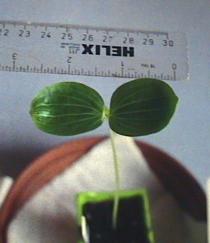
Obviously, we are unable to provide a more
reliable recipe for germination of this species than commiting
the seeds to the care of mother nature.
The first germinated seed was sown in a small
pot of compost and quickly grew to 'world record' size for a
delphinium seedling, measuring 7cm (2.75in) across the
cotyledons. Growth from then on was uneventful, producing a
rather lush plant with a hairy stem, fairly similar to the
closely related biennial species D. requienii but without
the glossy surface to the leaves. Unlike D. requienii, the
foliage has no offensive odour, even if crushed. The flower
spike emerged by early July and the flowers opened after another
two weeks.
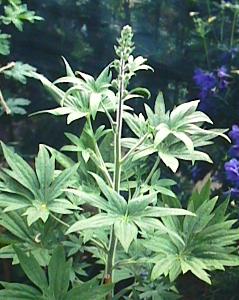 The bloom is a very
loosely-packed, tapered raceme with quite small individual
florets (40 mm diam.) held on stiff pedicels (90 mm long at base
of bloom) with a bract and a pair of bracteoles right at the
base. The bloom was 50cm long with 27 florets and the blooms of
the later plants were of similar size, giving plants with a total
height of 1.2m (4 ft). A notable feature of the floret is that the spur is
little more than a nob on the back and is far shorter than for
the smaller flowers of D. requieni.
The bloom is a very
loosely-packed, tapered raceme with quite small individual
florets (40 mm diam.) held on stiff pedicels (90 mm long at base
of bloom) with a bract and a pair of bracteoles right at the
base. The bloom was 50cm long with 27 florets and the blooms of
the later plants were of similar size, giving plants with a total
height of 1.2m (4 ft). A notable feature of the floret is that the spur is
little more than a nob on the back and is far shorter than for
the smaller flowers of D. requieni.
Flower development is interesting in that
sepals are greenish yellow on opening. Colour then develops quite
slowly, starting from a deep inky-blue edging, moving inwards
along the veins and spreading out until the sepals are completely
blue.
The petals forming the eye also become coloured
and the prominent anthers are purplish brown. The flowers of the
plants that grew outdoors in strong sunshine became quite purple,
so it is easy to see how one can be confused by descriptions of
the colour of this species given in Flora.
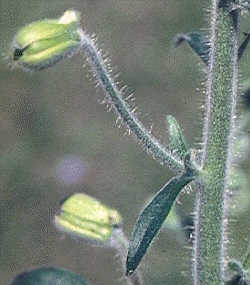 |
|
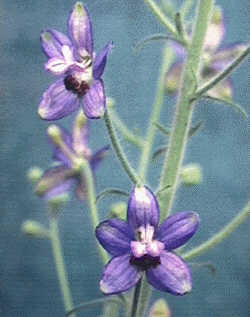 |
The flowers produced plentiful supplies of
pollen, so I tried cross-pollinating with D. requienii, using
emasculated florets of the latter as the seed parent. These set
seed, so the next step will be to find out what sort of plants
they produce. (Not done due
to house move) The flowers of D.
staphisagria also set seed quite readily but, at that stage,
the first plant suddenly developed a nasty fungal infection at
the base of the stem. It seemed likely to die before the seed
could mature so, in desperation, I cut off the bloom and kept it
in water containing Chrysal cut flower food for the next two
months. This worked and seeds developed even on some of the
laterals. Ripening of the seeds seems to be very slow under UK
conditions and those set on the plants in the ground were too
late to ripen at all. It
is interesting that even under bad conditions, seeds have their
characteristically large size. The
thick-skinned inflated seed pods contain just two or three seeds.
The seed yield from
this species is consequently much smaller than from D.
requienii, which produces 35+ smaller seeds
per floret. The plants die once the seed has ripened.
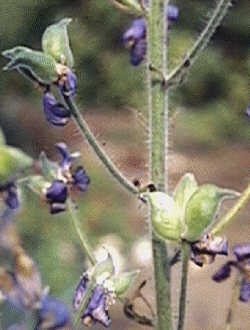
I ended with four times more seeds than I
started with. At this rate of multiplication I would never have
sufficient seed to offer D. staphisagria in the seed list
of the Delphinium Society. I have no regrets about this, as my
impression is that it has less to offer as a plant for garden
decoration than D. requienii.
I am
now satisfied that I have seen the full life cycle of this
fascinating plant. However, it must produce more seed in the
wild, or the ancient Greeks would not have had enough to make
insecticide powder. To check this, I would of course need a trip
to the Greek holiday islands to obtain personal experience of the
environment where it grows!
Notes on the
availability of seed of D. staphisagria
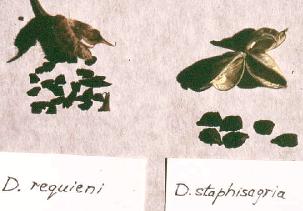 Seed said to be of this species is sometimes offered by
Commercial seed suppliers and Specialist Societies. This winter,
2000/2001, we ordered seeds from The Hardy Plant Society and
Chiltern Seeds. In both cases the seed is too small to be D.
staphisagria. We have checked with Prof. Cèsar Blanché, an
authority on delphiniums of the Mediterranean area, that seed
size is indeed a clear distinguishing feature between this
species and the rather similar D. requienii.
Seed said to be of this species is sometimes offered by
Commercial seed suppliers and Specialist Societies. This winter,
2000/2001, we ordered seeds from The Hardy Plant Society and
Chiltern Seeds. In both cases the seed is too small to be D.
staphisagria. We have checked with Prof. Cèsar Blanché, an
authority on delphiniums of the Mediterranean area, that seed
size is indeed a clear distinguishing feature between this
species and the rather similar D. requienii.
In our experience, seed of D. requienii
is smaller and of a recognisably different shape. Plants of this
species are extremely prolific seed producers and the seed
germinates very easily.
 Seed of D. staphisagria, which is a biennial, is
seldom available and my first attempts to grow it some years ago
were with seed Shirley obtained via seed exchanges between
Botanical Gardens and Universities. This time we bought seed
listed by the Archibalds, which had been collected from plants
growing among open scrub at 750m at Anapoli, Crete. The plant
name refers to the resemblance of the leaves to a grape or 'wild
raisin' but you could be forgiven for thinking it was the large
seeds that looked like raisins. They should certainly not be kept
in the cupboard with your dried fruit! The average size for the long
axis of 32 seeds was 6.2 mm and the average width across the
seeds was 5.2 mm. The seeds are angular with flat facets and a
rough, ridged dark brown skin.
Seed of D. staphisagria, which is a biennial, is
seldom available and my first attempts to grow it some years ago
were with seed Shirley obtained via seed exchanges between
Botanical Gardens and Universities. This time we bought seed
listed by the Archibalds, which had been collected from plants
growing among open scrub at 750m at Anapoli, Crete. The plant
name refers to the resemblance of the leaves to a grape or 'wild
raisin' but you could be forgiven for thinking it was the large
seeds that looked like raisins. They should certainly not be kept
in the cupboard with your dried fruit! The average size for the long
axis of 32 seeds was 6.2 mm and the average width across the
seeds was 5.2 mm. The seeds are angular with flat facets and a
rough, ridged dark brown skin. 
 The bloom is a very
loosely-packed, tapered raceme with quite small individual
florets (40 mm diam.) held on stiff pedicels (90 mm long at base
of bloom) with a bract and a pair of bracteoles right at the
base. The bloom was 50cm long with 27 florets and the blooms of
the later plants were of similar size, giving plants with a total
height of 1.2m (4 ft). A notable feature of the floret is that the spur is
little more than a nob on the back and is far shorter than for
the smaller flowers of D. requieni.
The bloom is a very
loosely-packed, tapered raceme with quite small individual
florets (40 mm diam.) held on stiff pedicels (90 mm long at base
of bloom) with a bract and a pair of bracteoles right at the
base. The bloom was 50cm long with 27 florets and the blooms of
the later plants were of similar size, giving plants with a total
height of 1.2m (4 ft). A notable feature of the floret is that the spur is
little more than a nob on the back and is far shorter than for
the smaller flowers of D. requieni. 


 Seed said to be of this species is sometimes offered by
Commercial seed suppliers and Specialist Societies. This winter,
2000/2001, we ordered seeds from The Hardy Plant Society and
Chiltern Seeds. In both cases the seed is too small to be D.
staphisagria. We have checked with Prof. Cèsar Blanché, an
authority on delphiniums of the Mediterranean area, that seed
size is indeed a clear distinguishing feature between this
species and the rather similar D. requienii.
Seed said to be of this species is sometimes offered by
Commercial seed suppliers and Specialist Societies. This winter,
2000/2001, we ordered seeds from The Hardy Plant Society and
Chiltern Seeds. In both cases the seed is too small to be D.
staphisagria. We have checked with Prof. Cèsar Blanché, an
authority on delphiniums of the Mediterranean area, that seed
size is indeed a clear distinguishing feature between this
species and the rather similar D. requienii.